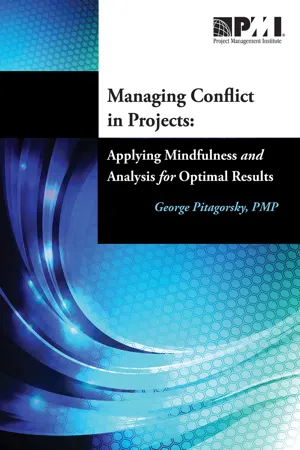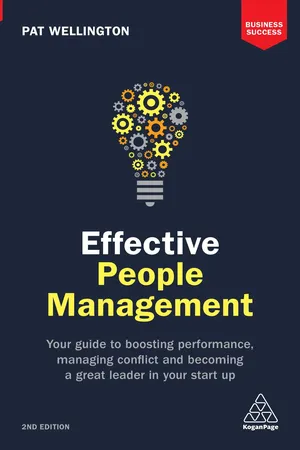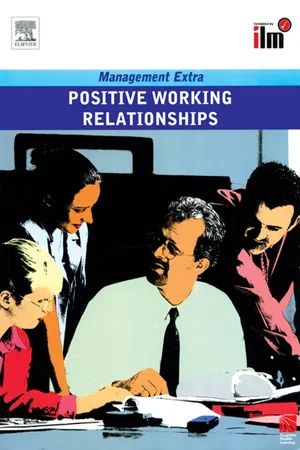Conflict Management
Conflict management involves the process of identifying and addressing conflicts within an organization to minimize their negative impact. It includes strategies for resolving disputes, fostering open communication, and promoting collaboration among team members. Effective conflict management can lead to improved relationships, increased productivity, and a more positive work environment.
7 Key excerpts on "Conflict Management"
- Vibrant Publishers(Author)
- 2020(Publication Date)
- Vibrant Publishers(Publisher)
...Chapter 5 Conflict Management Conflict is an unavoidable happening in any organization and may be initiated by an individual or group. Chapter five focuses on highlighting conflict and the various approaches that could dissolve it. This chapter provides readers with competency to explain the following: ● Definition and examples of conflict ● Characteristics of conflict ● The effects of conflict and the need to avoid it ● Different classifications of conflict ● Conflict resolution approaches and strategies ● Factors engendering conflict within an organization An organization relies on the peaceful coexistence of human resources, management, and the employer to do well. When there is a conflict between these groups, it forces the effect of underperformance, which leads to a low yield. A conflict could also be initiated by or involve other stakeholders such as customers, clients, boards, or volunteers. Therefore, a conflict must be avoided like a plague in any business setting or organization for any planned target to be possible. Conflict is anything that attracts unrest in an organized system. It is often a reaction to unfavorable policies. In a managerial sense, conflict is simply a deliberate agitating measure taken towards a plan of action or action in a company. It is often notable among human resources but prevalent in other faculties of an organization as well. Definition and Difficulties of Conflict Management Conflict Management is a reactive measure taken to weigh down the effects of conflict on a company’s general performance. The concept identifies the source of a problem, proffer, and implements a solution. Could conflict have a connection with compliance? Many human resource persons have at a time, wondered about the connection between conflict and regulatory compliance...
- Su Mi Dahlgaard-Park(Author)
- 2015(Publication Date)
- SAGE Publications, Inc(Publisher)
...Conflict Management Conflict Management 71 73 Conflict Management Conflicts emerging during service provision have a potentially negativeeffect on the quality of that service. Service failure is often the basisfor such conflicts and occurs when the service demanded is not received. If,for example, a customer misses a connecting train due to a delay, a conflictbetween the customer and the railway company is likely. Conflicts can arisewithin organizations and can have an impact on customer satisfaction,working efficiency, and employee satisfaction. This entry reviews thevarious types of conflict and then discusses the methodology of conflictmanagement with regard to conflict within organizations. Conflict Types Although it is used quite regularly, the term conflict is oftenapplied with distinctly varied meanings according to the user.Information technology (IT) specialists, for example, use the expression“to define a conflict” when dealing with two incompatible IT systems. Inthe context of management science, a conflict is understood to be asocial phenomenon that can be the result of people interacting with oneanother. A conflict can occur when individuals have diverging interestsand block one another from achieving their respective goals. However,the situations described are not real conflicts but rather stressfulsituations that can be resolved through negotiation or by executivedecision. A real conflict occurs when, in addition to the factualproblem, a personal problem arises between the parties. A conflict exists when people have differing ideas as to the importanceof specific issues; for example, the service development departmentcould have a different understanding of service quality than the servicefulfillment department. Another potential source for conflict is theabsence of a much-needed solution to a problem. Depending on theconflict, this situation could turn out to be either productive orineffective for an organization...
- eBook - ePub
- Craig E. Carroll(Author)
- 2016(Publication Date)
- SAGE Publications, Inc(Publisher)
...Matthew J. Dodd Matthew J. Dodd Dodd, Matthew J. Conflict Management Conflict Management 147 151 Conflict Management Conflict Management in organizations is the process of aligning individual expectations, goals, and relationships with organizational expectations, purpose, and culture to produce a healthy balance of task and relationship concerns. Conflict often has negative connotations, such as boycotts, protests, office politics between the powerful and the powerless, or other destructive conflict behaviors that motivate organizational leaders to suppress or deny conflict. Alternatively, research suggests that successful organizations engage in productive Conflict Management to strengthen interpersonal relationships, improve organizational culture, and increase productivity, without sacrificing organizational integrity. The sources of conflict in organizations are plentiful and sometimes complex. However, conflicts provide multiple opportunities to grow personally, develop stronger relationships, and create an organizational culture of peacemaking and productive conflict resolution. The negative connotations of conflict can overshadow the benefits of healthy conflict and its effective management. This entry defines organizational conflict as a difference of concerns within and/or between the six interconnected levels of organizations: (1) intrapersonal, (2) interpersonal, (3) intercultural, (4) interorganizational, (5) institutional, and (6) ideological. It then uses that multilevel systemic framework to provide effective strategies for productive Conflict Management in organizations. Organizational Conflict Defined The key components of conflict are human interaction, interdependence of the parties involved, perceived incompatibility of goals, limited availability of resources, and potential interference from others in achieving one’s goals. A brief explanation of these conflict components is warranted to set a foundational understanding of the concept...
- eBook - ePub
Managing Conflict in Projects
Applying Mindfulness and Analysis for Optimal Results
- George Pitagorsky(Author)
- 2012(Publication Date)
- Project Management Institute(Publisher)
...Chapter 11 Conclusion S ince Conflict Management is a process, it really has no end. It continues across projects and as multiple conflicts within projects. That is why process review is so important. In this final chapter, we will recap definitions and key points as a framework for you to use for assessing your Conflict Management process with an eye towards improvement on two levels: (1) your own process as applied to individual conflict events; and (2) your organization's process, given your ability to influence it. Definitions: Conflict and Conflict Management Conflict is disagreement between people with different perceptions, ideas, needs, or interests. It is inevitable in projects and in any relationship. Conflict can be an opportunity to reach an agreement that improves on the positions of the parties or an opportunity to win out over the competition. In projects, conflicts must be resolved quickly, with minimal effort and with optimal resolutions that further the project's success. Many conflicts can be considered as tasks on a critical path. At the same time, rushing to resolve conflicts or moving so fast as to postpone or avoid them when they naturally arise in project life can be just as damaging as taking an inordinately long time to resolve them. When conflict isn't present take it as a sign that something may be wrong. Avoid unnecessary conflict, but proactively promote conflict at the right times in project life and make each conflict event a perfect example of the work of a master conflict manager. Conflict Management is the process of applying skills, tools, and techniques to achieve the goals of optimal solutions, healthy relationships, personal growth, and continuous improvement in the way conflict is managed. It is a foundation skill that is essential to the health and performance of any relationship based organization, project, process or system. Conflict Management addresses conflict content and the relationships among the parties...
- eBook - ePub
Effective People Management
Your Guide to Boosting Performance, Managing Conflict and Becoming a Great Leader in Your Start Up
- Pat Wellington(Author)
- 2017(Publication Date)
- Kogan Page(Publisher)
...10 Proactive Conflict Management Introduction Conflict means disagreement, to battle, to be at odds. It seems to be an inevitable part of human interaction and occurs (at home or at work) when an individual’s needs, desires, values or intentions are in opposition with those of another person (or group). This definition suggests that those involved see their goals as incompatible and the achievement of these goals as being interfered with. Sometimes these differences are real, at other times they are imagined. Either way, the persons involved must see differences and believe they are important for conflict to emerge. If there are no differences there is no motivating force for conflict. The potential for conflict exists everywhere. At some time or other, we all find ourselves in situations where discussions spin out of control, and, instead of cooperating, we become emotional and angry, which if not managed and resolved effectively (and quickly) imposes significant personal (and organizational) cost on those involved. When the energies involved are under control they have potential for good. Out of control they can be forces for ill. A manager’s first priority is to view conflict as not always inherently bad. If handled correctly, the dynamics surrounding conflict can change radically. Some conflicts are relatively minor, easy to handle, or may be simply ignored. Others of greater magnitude require a strategy for successful resolution if they are not to create constant tension or lasting enmity at home or at work. If we recognize the causes that lead to conflict, we can usually steer ourselves and others away from the damage it can cause. I’m always surprised by the small things that can unleash a full-scale row, aggressive language (verbal or non-verbal) or taking actions calculated to annoy. The stages of a team’s development As a manager, your aim is to help your team reach and sustain high performance as quickly as possible...
- eBook - ePub
- Elearn(Author)
- 2009(Publication Date)
- Routledge(Publisher)
...Recognising and managing conflict Conflict is a frequent event in managers’ lives. You might find yourself arbitrating a conflict between two people you manage. You might be in disagreement yourself with a colleague who thinks differently from you or who is fighting for the same resources. You might inadvertently exacerbate existing conflicts, either by being unaware of them or by jumping to conclusions too quickly. People react very differently to conflict. Stop and think for a minute about your own response. Do you battle the issues head on? Do you negotiate a compromise or do you prefer to avoid conflict altogether? Although we have natural preferences, we are all capable of using a range of styles and no particular response is correct every time. The more aware you are of your personal style and the more ways you can see of resolving a particular conflict, the more considerate and successful you will be in solving the problem. In this theme, you will: Identify sources of conflict and enhance your ability to recognise conflicts and disagreements at work Examine the role of the manager in managing conflict so that it does not become damaging to the individual or organisations involved Reflect on the range of strategies that you use to deal with conflict and consider how you can develop these further. Why does conflict happen? Interpersonal conflict occurs between two or more persons when attitudes, motives, values, expectations or activities are incompatible and if those people perceive themselves to be in disagreement. Source: Hunt (1982) Few organisations are immune to conflict–indeed Fisher, Ury and Patton (1991) comment that ‘conflict is a growth industry’...
- eBook - ePub
- John Gennard, Graham Judge, Tony Bennett, Richard Saundry(Authors)
- 2016(Publication Date)
- CIPD - Kogan Page(Publisher)
...A Health and Wellbeing Steering Group identifies conflict stress ‘hotspots’ within the organisation by analysing a range of key indicators. A range of interventions are then considered and deployed including individual mediation, targeted training, stress risk assessments, team facilitation and conflict coaching. Source: Latreille and Saundry (2015) The case of Northumberland Healthcare Trust highlights a number of principles that arguably underpin effective Conflict Management: The management of conflict needs to be seen as a strategic issue – critical in underpinning well-being, engagement and performance. Conflict resolution and people skills should be viewed as a core competence for frontline managers. Working in partnership with organisational stakeholders is crucial in facilitating early and informal resolution of conflict. Organisations need to combine traditional disciplinary and grievance procedures with a range of alternative dispute resolution (ADR) approaches and tools. Conflict Management intervention needs to be flexible and based on systematic analysis of data. 11.6 SUMMARY In this chapter we have provided an overview of the nature and pattern of workplace conflict and examined the key factors that shape the ability of organisations to manage it effectively. It is almost impossible to say whether there has been any reduction or increase in workplace conflict in recent years. However, the last 20 to 30 years have seen a fundamental shift in the channels through which workplace conflict is expressed. The decline of trade unions and the collective regulation of employment have seen a significant decline in the use of strike action and a relative increase in individual employment disputes...






